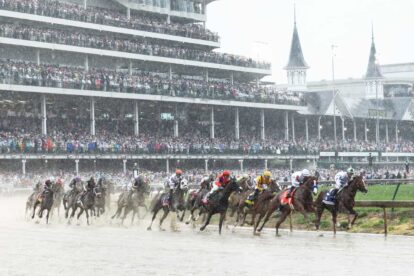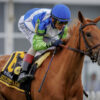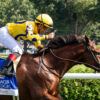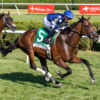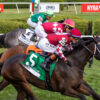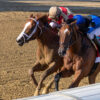It’s the fastest two minutes in sports and also the most scrutinized, evaluated, and over-analyzed race of the year.
The Kentucky Derby is Americana and its history is the thing legends are made of.
The rich history of the Derby also allows analysts to spend hours pouring over statistical scrolls and lore to come up with wacky theories on how the race will be run each year.
Admittedly, I am one of those analysts that perseverates over the way the Kentucky Derby is run and have developed some theories that have served me well.
Yes, it’s been easy to pick the winner of the Derby the past six years in the new Kentucky Derby Points Era, since the betting favorite has won every year, but in the meantime, I’ve also concocted a formula to help predict how the race will unfold using historical Brisnet running style data.
My Pace Thesis the past three years has predicted the chalky 2016 Derby trifecta box, won the Ron Rippey Award for Handicapping Media in 2017 for predicting the Derby pace and winner Always Dreaming, and last year landed me the 2018 exacta straight with Justify over Good Magic.
I promise I’m not bragging because as soon as you do that nonsense, it’ll make you penniless, so I’m just going to keep grinding, stay humble and try to do my best to predict how the race will be run and won this year.
How fast will they go early is always the first question I ask. To answer that question, we’ll first take a look at the Brisnet running styles of the horses projected to run in this year’s Derby.
Next, I’ll compare this year’s Derby field to all the fields since 2001 to find similarities in this field to recent runnings of the Derby.
Finally, we’ll start looking at the horses that can set the Derby pace and how they’ve been running lately to discern how fast they’ll go. This is just the Pace Thesis preview and we’ll build on the analysis here to finalize our hypothesis and picks for the 2019 Kentucky Derby after the post position draw next week.
THE PROJECTED 2019 KENTUCKY DERBY FIELD
The table below shows the Brisnet running styles of the top 20 horses expected to run in the 2019 Kentucky Derby ordered by fastest horses with early speed to slowest horses that are expected to be farthest back to start the race:

Another way to look at the table above is that the Brisnet running styles help order who is most likely to set the pace in the Derby. For those not fluent in horse racing lingo, the pace of a horse race is defined as how fast the early leaders will go and how the race will develop.
Horses naturally demonstrate a type of running style in which they’re the most comfortable and will find the most success. Analyzing all 20 Derby horses’ running styles is imperative for predicting how the race will unfold.
Horses’ running styles are defined by many services, including Brisnet, and the color code in the table above represents the four types of Brisnet running styles:
E for Early – horses that will show early speed and need to lead (Green)
E/P for Early/Presser – horses that will want to be nearer to the early pace and stalk (Yellow)
P for Presser – horses that will be in the middle of the Derby pack (Orange)
S for Sustained or Closer – horses that will be farther back to start the race and will look to make one sustained run late.
The number next to the run style represents the early speed points. The numbers range from 0-8 and measure the Early Speed of the horse based on its running position and beaten lengths at the first call of recent races. The higher the number, the more early speed a horse has shown in recent races.
From the table above, there is only one horse with an Early (E) running style and that is likely Derby betting favorite Omaha Beach. He has 8 early speed points making him a horse that will likely be on or near the lead in the Derby. We’ll talk a lot more about him later in the article and the final Pace Thesis.
There are 10 horses that exhibit the Early/Presser (E/P) running style, so more than half of the field will want to be near the early pace.
How does this relate to how fast they’ll run early? Well, let’s see next how this field stacks up historically.
Want more thoughts from Saratoga Slim on the Derby? See bonus analysis in our Inside Track to the Kentucky Derby wagering guide!
PREDICTING THE 2019 KENTUCKY DERBY PACE BASED ON HISTORICAL DATA
A few years ago, I downloaded a .pdf file from the Brisnet website with all the Kentucky Derby past performances going back to 2001. Trained as an engineer, I started cranking through the data to see if I could find any trends.
The first thing I started to notice was races that had more than one E8 horse entered resulted in faster Derby paces.
Since “E8” horses have the most early speed and are “need the lead” types, it’s natural that when two horses with these characteristics “hook up” on the front end that they will press each other and a fast pace will ensue.
Again, not surprisingly, 7 of the top 8 fastest Derbies in the past 18 years have featured fields with more than 2 horses entered with the “E8” horse running style (see table below sorting the last 18 Derbies in order from fastest to slowest ¾ mile fractional time):

The five fastest Derbies each had two or more E8 horses entered, including most recently in the 2016 Derby, which had the fifth-fastest pace in the past 18 years. Even with a fast pace that year, Nyquist and Gun Runner finished first and third after attending a fast pace.
After looking at the E8 horses, next, I wanted to take the analysis another step and see if there were any trends with the amount of E and E/P horses in the race.
I created the “Brisnet Derby Field Speed” metric, which is just a calculation averaging the early speed points of all E and E/P horses in the Derby field. The results give us a clear picture of how fast we can predict the horses to run early based on the running styles in the field.
The table below once again shows the last 18 Derbies in order of the fastest first 3/4-mile times and adds the columns of “Total of E and E:P horses” in the race and most importantly, the Brisnet Derby Field Speed (BDFS) for each year:

Averaging the BDFS in the table above, the seven fastest paces averaged a BDFS of 6.32.
The five moderately paced Derbies averaged a BDFS of 6.11.
Finally, the six slowest Derbies averaged a BDFS of only 5.56.
This year’s Derby field has a Brisnet Derby Field Speed of only 5.36, ranking it the 17th-lowest in the past 19 years. This indicates a slow pace and with only one E8 horse entered, there’s reason to believe they will go really slow early.
This is important because if the horses that are near the early lead don’t have to go fast in the opening 3/4 mile of the race, then they’ll have more energy left late in the race to hold onto the top finishing positions. The horses farther back won’t have the opportunity to close into the slow pace thwarting their attempt to pass the front-runners as they all approach the finish line.
The 2015 Derby is a key race to compare to this year’s Derby field. That year, the Brisnet Derby Field Speed was 5.64 and had a total of 11 E & E/P horses entered, just like this year. Additionally, the field had one E8 horse entered. As most E8 horses do, Dortmund set the early pace with slower fractions of 47.34 and 1:11.29 in the first 1/2-mile and 3/4-mile of the race, ranking as the sixth-slowest Derby in the past 18 years.
Both American Pharoah and Firing Line were able to sit close to the early slow pace and had plenty left in the stretch to finish first and second with Dortmund finishing third in a race that could be called a merry-go-round.
PREVIEW OF THE 2019 KENTUCKY DERBY EARLY PACE
The 2015 Derby equates well to this year because the best horses in both years all showed the ability to flash early speed and still have the ability to excel going the 1 1/4 mile distance of the Kentucky Derby.
There isn’t a true standout this year like Triple Crown winner American Pharoah in 2015, but likely betting favorite Omaha Beach won the Grade 2 Rebel Stakes and Grade 1 Arkansas Derby, just like Pharoah did. Omaha Beach doesn’t come into this year’s Derby with the hype Pharoah had, but he’s a very good horse with early speed and Hall-of-Fame jockey Mike Smith at the controls.
Omaha Beach is rated an E8 Brisnet Running Style, but isn’t a true need-the-lead type. In the Rebel, he broke out of the gate on top but was content to sit behind the early pacesetters and then took over the lead when asked on the backstretch. In the Arkansas Derby, he broke out of the gate behind four others but was quickly rushed up by Smith to take control of the lead as they entered the backstretch. Omaha Beach isn’t a typical E8 horse and Smith will hustle him out of the Derby gate to get coveted early position, but then will likely take back to sit off a pacesetter.

If Omaha Beach doesn’t set the pace, then the most likely horse to do so will be Maximum Security, who won the Grade 1 Florida Derby in gate-to-wire fashion. Maximum Security set an extremely slow pace with 1/2-mile and 3/4-mile fractions of 48.98 and 1:12.90 to win the Florida Derby. If he does the same in the Kentucky Derby, it would the slowest 1/2-mile and second slowest 3/4-mile run in the Derby this millennium. It’s unlikely that Maximum Security will get away with such tepid fractions in the Kentucky Derby, as he’ll need to show early pep to get the lead from the gate with 19 others pushing him, but once he strikes the lead, he will get a chance to breathe with no pure sprinters pushing him.
A fast or even moderate pace is unlikely this year with no sprinters entered to speed up the pace, thanks in part to the change in the Derby Points Era, where recent 1 1/16 mile and 1 1/8 mile prep winners receive most of the points to qualify for the gate.
Who will even try to press Maximum Security? Besides Omaha Beach, maybe Spinoff or Vekoma decide to go with the early leader, but neither has been on the lead early in their recent races and would both be content to settle a couple of lengths off the lead.
All signs are pointing to a slow pace in this year’s Derby that will benefit the first flight of horses to finish in the top four. Right now it can be predicted that the first 1/2 mile of the Derby will be run in 47.30 and the 3/4-mile will be run in 1:11.40 making it the 14th slowest in the past 19 years.
In the final Pace Thesis that will be on RacingDudes.com after the post position draw on Tuesday, I’ll step through each horse in the race and where they’ll sit early. Additionally, we’ll delve deep into which horses will be forwardly placed in the race and will have an advantage with a slow pace expected. Who has the early speed, pedigree and has shown the stamina to excel at the Derby distance? Those assets will be the key to evaluate when betting the 2019 Derby and we’ll expand on these theories next week: DERBY WEEK!
In the meantime, please follow me on Twitter @SaratogaSlim for my thoughts leading up to the Derby and for on-site coverage of Kentucky Oaks and Derby days live from Churchill Downs. Yes, I’ll be at the Derby for the second year in a row living it up, so make sure to get in touch if you’ll be there and follow along!

